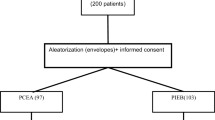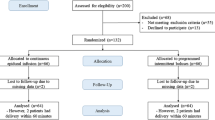Abstract
Programmed intermittent epidural bolus (PIEB), administered by the infusion pump programmed to deliver boluses of epidural solution at certain intervals, is gradually gaining more attention as a technique to maintain the labor analgesia in recent years. Many studies find that it may have some advantages when compared with other methods. However, its exact effectiveness and optimal regimen are still unclear. We conducted a literature search in PubMed, Web of Science, and Cochrane Database of Systematic Reviews for studies published between January 2010 and June 2022. Of the 263 publications identified, 27 studies were included. The purpose of this review is to discuss the effects of PIEB with continuous epidural infusion (CEI) and patient-controlled epidural analgesia (PCEA) in maintenance of epidural labor analgesia on labor outcomes and elucidate the latest research progress of implementation strategies.
Similar content being viewed by others
Data availability
The data of this work are available from the corresponding author upon reasonable request.
References
Hiltunen P, Raudaskoski T, Ebeling H, Moilanen I. Does pain relief during delivery decrease the risk of postnatal depression? Acta Obstet Gynecol Scand. 2004;83(3):257–61.
Shnider SM, Wright RG, Levinson G, Roizen MF, Wallis KL, Rolbin SH, Craft JB. Uterine blood flow and plasma norepinephrine changes during maternal stress in the pregnant ewe. Anesthesiology. 1979;50(6):524–7.
Sng BL, Zeng Y, de Souza NNA, Leong WL, Oh TT, Siddiqui FJ, Assam PN, Han NR, Chan ES, Sia AT. Automated mandatory bolus versus basal infusion for maintenance of epidural analgesia in labour. Cochrane Database Syst Rev. 2018;5:CD011344.
Lim G, Facco FL, Nathan N, Waters JH, Wong CA, Eltzschig HK. A review of the impact of obstetric anesthesia on maternal and neonatal outcomes. Anesthesiology. 2018;129(1):192–215.
Onuoha OC. Epidural Analgesia for Labor. Anesthesiol Clin. 2017;35(1):1–14.
Capogna G, Camorcia M, Stirparo S, Farcomeni A. Programmed intermittent epidural bolus versus continuous epidural infusion for labor analgesia: the effects on maternal motor function and labor outcome. A randomized double-blind study in nulliparous women. Anesth Analg. 2011;113(4):826–31.
Sia AT, Leo S, Ocampo CE. A randomised comparison of variable-frequency automated mandatory boluses with a basal infusion for patient-controlled epidural analgesia during labour and delivery. Anaesthesia. 2013;68(3):267–75.
Heesen M, Bohmer J, Klohr S, Hofmann T, Rossaint R, Straube S. The effect of adding a background infusion to patient-controlled epidural labor analgesia on labor, maternal, and neonatal outcomes: a systematic review and meta-analysis. Anesth Analg. 2015;121(1):149–58.
Ferrer LE, Romero DJ, Vasquez OI, Matute EC, Van de Velde M. Effect of programmed intermittent epidural boluses and continuous epidural infusion on labor analgesia and obstetric outcomes: a randomized controlled trial. Arch Gynecol Obstet. 2017;296(5):915–22.
Ojo OA, Mehdiratta JE, Gamez BH, Hunting J, Habib AS. Comparison of programmed intermittent epidural boluses with continuous epidural infusion for the maintenance of labor analgesia: a randomized, controlled, double-blind study. Anesth Analg. 2020;130(2):426–35.
Haidl F, Arne Rosseland L, Rorvik AM, Dahl V. Programmed intermittent boluses vs continuous epidural infusion in labor using an adrenaline containing solution: A randomized trial. Acta Anaesthesiol Scand. 2020;64(10):1505–12.
Riazanova OV, Alexandrovich YS, Guseva YV, Ioscovich AM. A randomized comparison of low dose ropivacaine programmed intermittent epidural bolus with continuous epidural infusion for labour analgesia. Rom J Anaesth Intensive Care. 2019;26(1):25–30.
Fan Y, Hou W, Feng S, Mao P, Wang X, Jiang J, Yuan H, Shen X, Feng S, Li P. Programmed intermittent epidural bolus decreases the incidence of intra-partum fever for labor analgesia in primiparous women: a randomized controlled study. Arch Gynecol Obstet. 2019;300(6):1551–7.
Xu J, Zhou J, **ao H, Pan S, Liu J, Shang Y, Yao S. A systematic review and meta-analysis comparing programmed intermittent bolus and continuous infusion as the background infusion for parturient-controlled epidural analgesia. Sci Rep. 2019;9(1):2583.
Wang XX, Zhang XL, Zhang ZX, **n ZQ, Guo HJ, Liu HY, **ao J, Zhang YL, Yuan SZ. Programmed intermittent epidural bolus in parturients: a meta-analysis of randomized controlled trials. Medicine (Baltimore). 2022;101(5): e28742.
Bullingham A, Liang S, Edmonds E, Mathur S, Sharma S. Continuous epidural infusion vs programmed intermittent epidural bolus for labour analgesia: a prospective, controlled, before-and-after cohort study of labour outcomes. Br J Anaesth. 2018;121(2):432–7.
Lin Y, Li Q, Liu J, Yang R, Liu J. Comparison of continuous epidural infusion and programmed intermittent epidural bolus in labor analgesia. Ther Clin Risk Manag. 2016;12:1107–12.
Holgado CM, Girones A, Tapia N, De Molina-Fernandez MI, Anez C. Labor outcomes with epidural analgesia: an observational before-and-after cohort study comparing continuous infusion versus programmed intermittent bolus plus patient-controlled analgesia. Minerva Anestesiol. 2020;86(12):1277–86.
Liu X, Zhang H, Zhang H, Guo M, Gao Y, Du C. Intermittent epidural bolus versus continuous epidural infusions for labor analgesia: A meta-analysis of randomized controlled trials. PLoS ONE. 2020;15(6): e0234353.
Hogan Q. Distribution of solution in the epidural space: examination by cryomicrotome section. Reg Anesth Pain Med. 2002;27(2):150–6.
Mowat I, Tang R, Vaghadia H, Krebs C, Henderson WR, Sawka A. Epidural distribution of dye administered via an epidural catheter in a porcine model. Br J Anaesth. 2016;116(2):277–81.
Lim Y, Sia AT, Ocampo C. Automated regular boluses for epidural analgesia: a comparison with continuous infusion. Int J Obstet Anesth. 2005;14(4):305–9.
Roofthooft E, Barbe A, Schildermans J, Cromheecke S, Devroe S, Fieuws S, Rex S, Wong CA, Van de Velde M. Programmed intermittent epidural bolus vs. patient-controlled epidural analgesia for maintenance of labour analgesia: a two-centre, double-blind, randomised studydagger. Anaesthesia. 2020;75(12):1635–42.
Bourges J, Gakuba C, Plass F, Gerard JL, Simonet T, Hanouz JL. Effect of patient-controlled epidural analgesia with and without automatic intermittent bolus on levobupivacaine consumption during labour: A single-centre prospective double-blinded randomised controlled study. Anaesth Crit Care Pain Med. 2021;40(5): 100936.
Song Y, Du W, Zhou S, Zhou Y, Yu Y, Xu Z, Liu Z. Effect of dural puncture epidural technique combined with programmed intermittent epidural bolus on labor analgesia onset and maintenance: a randomized controlled trial. Anesth Analg. 2021;132(4):971–8.
Wong CA, McCarthy RJ, Hewlett B. The effect of manipulation of the programmed intermittent bolus time interval and injection volume on total drug use for labor epidural analgesia: a randomized controlled trial. Anesth Analg. 2011;112(4):904–11.
Epsztein Kanczuk M, Barrett NM, Arzola C, Downey K, Ye XY, Carvalho JC. Programmed intermittent epidural bolus for labor analgesia during first stage of labor: a biased-coin up-and-down sequential allocation trial to determine the optimum interval time between boluses of a fixed volume of 10 ml of bupivacaine 0.0625% with fentanyl 2 mug/mL. Anesth Analg. 2017;124(2):537–41.
Bittencourt R, Arzola C, Zakus P, Downey K, Ye XY, Carvalho JCA. A biased coin up-and-down sequential allocation trial to determine the optimum programmed intermittent epidural bolus time interval between 5 mL boluses of bupivacaine 0.125% with fentanyl 2 microg.mL(-1). Can J Anaesth. 2019;66(9):1075–81.
Shatalin D, Arzola C, Downey K, Ye XY, Carvalho JCA. Programmed intermittent epidural bolus for labour analgesia during first stage of labour: a sequential allocation trial to determine the effective interval time between boluses of a fixed volume of 2.5 mL of bupivacaine 0.25% plus fentanyl 8 microg.mL(-1). Can J Anaesth. 2021;68(5):653–60.
Zhou SQ, Wang J, Du WJ, Song YJ, Xu ZD, Liu ZQ. Optimum interval time of programmed intermittent epidural bolus of ropivacaine 0.08% with sufentanyl 0.3 mug/mL for labor analgesia: a biased-coin up-and-down sequential allocation trial. Chin Med J (Engl). 2020;133(5):517–22.
Li B, Yuan S, Chen A, Ma D, Fu W. Programmed intermittent epidural bolus at different intervals combined with patient-controlled epidural analgesia on body temperature during labour analgesia. J Coll Physicians Surg Pak. 2020;30(5):463–6.
Krawczyk P, Piwowar P, Salapa K, Lonc T, Andres J. Do epidural catheter size and flow rate affect bolus injection pressure in different programmed intermittent epidural bolus regimens? An In Vitro Study Anesth Analg. 2019;129(6):1587–94.
Klumpner TT, Lange EM, Ahmed HS, Fitzgerald PC, Wong CA, Toledo P. An in vitro evaluation of the pressure generated during programmed intermittent epidural bolus injection at varying infusion delivery speeds. J Clin Anesth. 2016;34:632–7.
Lange EMS, Wong CA, Fitzgerald PC, Davila WF, Rao S, McCarthy RJ, Toledo P. Effect of epidural infusion bolus delivery rate on the duration of labor analgesia: a randomized clinical trial. Anesthesiology. 2018;128(4):745–53.
Mazda Y, Arzola C, Downey K, Ye XY, Carvalho JCA. Programmed intermittent epidural bolus for labour analgesia: a randomized controlled trial comparing bolus delivery speeds of 125 mL.hr(-1) versus 250 mL.hr(-1). Can J Anaesth. 2022;69(1):86–96.
Sultan P, Murphy C, Halpern S, Carvalho B. The effect of low concentrations versus high concentrations of local anesthetics for labour analgesia on obstetric and anesthetic outcomes: a meta-analysis. Can J Anaesth. 2013;60(9):840–54.
Zhang L, Hu Y, Wu X, Zhang X. A systematic review and meta-analysis of randomized controlled trials of labor epidural analgesia using moderately high concentrations of plain local anesthetics versus low concentrations of local anesthetics with opioids. J Pain Res. 2021;14:1303–13.
Author information
Authors and Affiliations
Contributions
PZ and FN contributed to the study conception and design. FN performed the literature search and data analysis. FN drafted and ZW critically revised the work. All authors commented on previous versions of the manuscript. All authors read and approved the final manuscript.
Corresponding author
Additional information
Publisher's Note
Springer Nature remains neutral with regard to jurisdictional claims in published maps and institutional affiliations.
About this article
Cite this article
Ni, F., Wu, Z. & Zhao, P. Programmed intermittent epidural bolus in maintenance of epidural labor analgesia: a literature review. J Anesth 37, 945–960 (2023). https://doi.org/10.1007/s00540-023-03253-w
Received:
Accepted:
Published:
Issue Date:
DOI: https://doi.org/10.1007/s00540-023-03253-w




